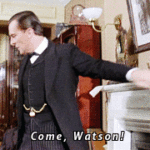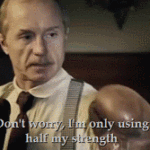I was reading the rest of thor bridge on the team on the way home and when I got to the bit where they have the first class carriage to themselves and Holmes puts his hands on Watson’s knees and smiles mischievously, I turned the book so my neighbour couldn’t see what I was reading
just by instinct
the way I do when I’m reading fan fiction in public and things get steamy
then I realised what I was doing and stopped it but it was hard because that scene is just so intimate
@handbasketofdreams You were right though, in context. Because if, at the time the story was written, anyone had caught two men, sitting opposite each other in a railway carriage, one learning forward, gazing mischievously at the other, hands on the other’s knees, it would have been an act that could later have been brought up in a trial as evidence of improper behaviour between them – behaviour which, with other evidence, might lead to conviction under Section 11 of the 1885 Criminal Law Amendment Act
As it was evidence, and did lead to conviction, at various points in the Dublin Castle Scandal of 1884, the Cleveland Street Scandal of 1889, and the Wilde Trials in 1895.
“He put his hand on my knee” (in a cab, in a carriage, in the Botanic Gardens, while we were having a drink together, in his rooms … and then sex followed shortly after) comes up in all three trials. It was an unmistakable signal of intent. More, it was a recognised signal of intent: an invitation, and if not summarily rejected, a willing acquiescence.
Which also gives rather more point to John’s hand on Sherlock’s knee in TSOT, doesn’t it?
A good point. I didn’t know it came up in all the trials! I wonder how gay readers of the story felt at the time. Did they blush? Did they hide their copy of the Strand? Were they worried Doyle had been too obvious? Or did it feel like a secret signal just for them?
@handbasketofdreams I don’t know. But the more you read Doyle’s work, the more you look at how he behaved, the crushes he had on men, the way he writes men, his support for Oscar Wilde and Roger Casement, the more you think that there was some understanding there, some consciousness, some definite attempt to position Holmes as homosexual, or at very least to valourise, validate and celebrate romantic, homoerotic male friendships.
Who knows if he ever seriously contemplated it for himself? In his letters he speaks about having made some conscious, overt choice for his path in life: it sounds as if he made it when he married his first wife, whom he cared for very much, but who, as he said long after her death, was ‘dear, but never darling’.
I think he signals, yes. I think he knew there were readers who would instinctively recognise Holmes as gay, and Watson as his partner, with the Watson marriage being a polite fiction: an attempt to appear normal.
(There were lots of people Doyle knew from society who were married but gay. Some were genuinely bisexual, others I think, not.)
His brother-in-law, Hornung, who wrote the Raffles books – much, much more overtly gay – dedicated them to Doyle, though. There was some understanding of what the relationships really meant there.
I think gay male readers often Holmes stories would have understood, and blushed. But the information was too coded for most people to get – as it had to be.
Thank you for these thoughtful additions. To me, too, it seems as if Doyle had several crushes on men, whether he acted on them (or even recognised them as such) or not. It is clear he was supportive of gay men and counted several among his friends, and I am increasingly convinced he deliberately coded Holmes as a gay man and intended for him and Watson to be read as life-long partners.
fascinating, i really must spend the time on the book of ACD’s letters, i get so wrapped up in the tablet i forget to read a book.
Thank you @artemisastarte and @handbasketofdreams for the amazing discussion!

Just another WordPress site




























